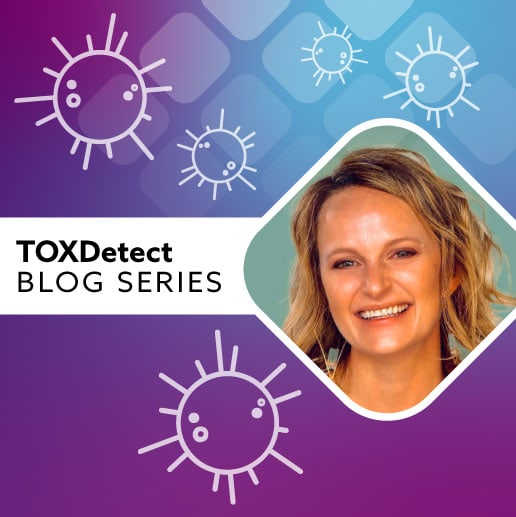Specific Toxic Substances and the OAT
Mold Exposure
Mold exposure, often an overlooked influence on chronic illness, can be challenging to detect. The OAT can further assist in this detection process by looking at fungal activity and mycotoxin metabolism versus exclusive excretion of mycotoxins.
Specific organic acid markers such as 5-Hydroxymethyl-2-furoic acid (HMFA), Furan-2,5-dicarboxylic acid, and Furancarbonylglycine, are byproducts of Aspergillus sp. mold, and can give potential insights into its activity.1,2,3 Humans can encounter Aspergillus commonly through contaminated food and water-damaged buildings, as well as outdoor environments.4
Fusarium mold exposure can also be indicated on the OAT. Tricarballylic acid, can increase due to exposure to fumonisins, a type of mycotoxin produced by Fusarium mold, which is commonly found in corn products.5 Additional effects, such as influences on dopamine metabolism, as well as dysbiosis, can result from mycotoxin exposure; yet, due to the numerous other variables that can influence these markers, assessing them from a mold standpoint should be done in the context of an exposure.6,7,8
Additionally, both citramalic and tartaric acid have also been reported to be Aspergillus byproducts and thus may reflect exposure.9,10,11,12 However, since other fungi can also produce these markers, they should be used in conjunction with other mold-related markers for further insight when assessing mold exposure.13,14
Heavy Metals
Heavy metals are pervasive sources of toxin exposure, and the OAT may reflect this exposure through specific organic acids.
Although there are a number of reasons why homovanillic (HVA) or vanillylmandelic acid (VMA) can be elevated, toxic metal exposure has been shown to be one causation.15,16 Similarly, pyruvic acid can be elevated by several metals such as arsenic, cadmium, mercury, and antimony.17,18,19, 20 Citric acid, specifically can be elevated due to arsenic exposure due to arsenics ability to decrease the activity of the enzyme aconitase, which converts cirate to isocitrate.21
Pesticides, Phthalates, Solvents, and Other Toxicants
These environmental toxicants can additionally be reflected through abnormalities in organic acid markers.
Pesticides, for example, can have a direct effect on dopamine metabolism, resulting in altered levels of HVA and DOPAC (3,4-dihydroxyphenylacetic acid).21 They can also impact our microbiome by reducing beneficial bacteria contributing to occurrences of pathogenic dysbiosis.22,23 Both glyphosate and organophosphates have been shown to influence Clostridia bacteria, measured on the OAT by 4-hydroxyphenylacetic acid, HPHPA (3-(3-hydroxyphenyl)-3-hydroxypropionic acid), 4-cresol, and 3-Indolacetic acid.24,25
Phthalates, which are endocrine disruptors found in numerous products throughout our environment, can raise quinolinic acid (QA) levels by inhibiting the enzyme that allows QA to convert to nicotinamide.26 This backup in the pathway can produce excessive levels of QA, causing neuroinflammation.27
Solvents such as styrene and toluene can also be reflected through organic acid values. Styrene, a neurotoxin used in the production of various materials and products, can lead to elevated levels of mandelic acid, which is a metabolite involved in the phenylalanine to dopamine pathway.28,29 Hippuric acid, associated with dysbiosis on the OAT, is a major metabolite to identify exposures to toluene, a reproductive toxin found in crude oil and various manufactured products.30 Oxalic acid has a known relationship with foods and fungus; however, it can reflect exposures to ethylene oxide, or one of it’s biproducts, ethylene glycol, used in plastics, textiles, and antifreeze. 31
Parabens, a toxicant used as a preservative, can be measured by 4-Hydroxybenzoic and 4-Hydroxyhippuric acids, which are additionally used as a dysbiosis marker on the OAT. 32,33,34 Acrolein known to come from endogenous lipid peroxidation, is also a synthetic chemical used in acrylics, fuel combustion, plastics, and can be generated when cooking oils exceed their smoke point. 36 37 Regardless of source, it can be metabolized into malonic acid (74), a marker on the OAT usually associated with genetic abnormalities. 38 39
It should be noted that neither toluene nor acrolein are currently available on TOXDetect Profile™, however testing may still be valuable to assess for other toxic burdens, as it is common to have multiple exposures.
Additional Insights Indicating Toxic Exposure
Gut Health
Arabinose, an indicator of Candida overgrowth, can be influenced by toxic environmental compounds.35,36 Both mycotoxins and toxicants can disrupt the gut microbiome, weaken the intestinal epithelial barrier, and influence the immune system, all of which can increase the likelihood of Candida overgrowth.37,38,39,40
Mitochondrial Stress
While many factors, including toxic chemicals, can affect mitochondria, one enzyme is especially vulnerable: succinate dehydrogenase. This enzyme, responsible for converting succinate to fumarate, has been shown to be inhibited by various toxic substances such as chemical toxicants, mycotoxins, and heavy metals.41,42,43,44,45 Succinate is an important part of the connection between the Krebs cycle and the Electron Transport Chain (ETC) and can significantly influence energy production.46
Detoxification Pathways
The OAT can also offer insight into detoxification processes, which can be influenced by toxic chemical exposure.
Pyroglutamic acid is a metabolite that reflects glutathione (GSH) status, and when elevated, it can indicate insufficient glutathione levels, or a high demand for glutathione.47 Exposures to toxicants, heavy metals, and mycotoxins can influence glutathione levels, either through oxidative stress, increased demands on detoxification, or even by blocking GSH pathways, all of which can lead to potential insufficiencies.48,49,50
2-Hydroxybutyric acid, an intermediate metabolite of homocysteine metabolism, can allude to potential toxicity.51 When elevated, it may infer homocysteine is favoring the transsulfuration pathway due to either; a high demand for cysteine to support glutathione levels, or decreased functionality of the methylation pathway, both of which can potentially be induced by toxic chemical overload.52
Summary
The OAT provides a comprehensive overview of multiple metabolic pathways and can be a valuable tool in identifying potential exposures to various environmental toxins. Once the OAT reveals potential exposures to toxin burden, further testing can be done to quantify specific toxin exposures. MosaicDX offers several tests such as TOXDetect Profile®, MycoTOX Profile™, Glyphosate Test, and Metals tests to evaluate specific toxicants.
It is important to remember that any abnormalities should be discussed with a healthcare professional to understand their potential implications and to determine appropriate steps for mitigation.
OAT and Toxic Exposure Crosswalk
The following chart focuses on organic acids that have a relationship with toxic exposures.
Summary
TOXDetect Profile® offers a comprehensive approach to evaluating environmental toxicant exposures, complemented by a thorough environmental exposure history intake. This combination equips practitioners with insights needed to understand how toxicants influence patient health and to implement evidence-based avoidance strategies, address health impacts, and tailor personalized therapeutic interventions. Our goal is to empower you to proactively mitigate the effects of environmental toxicants, fostering long-term health and well-being for both you and your patients.

References
- Kimura Y, Tani S, Hayashi A, Ohtani K, Fujioka S, Kawano T, Shimada A. Nematicidal activity of 5-hydroxymethyl-2-furoic acid against plant-parasitic nematodes. Z Naturforsch C J Biosci. 2007 Mar-Apr;62(3-4):234-8. doi: 10.1515/znc-2007-3-413. PMID: 17542490.
- Omana Rajesh R, Shruthy NS, Akhila S, Krishnan Godan T, Dileep NR, César de Carvalho J, Porto de Souza Vandenberghe L, Ricardo Soccol C, Sindhu R, Binod P. Whole-cell synthesis of 2,5-furandicarboxylic acid from pineapple waste under various fermentation strategies. Bioresour Technol. 2023 Oct;386:129545. doi: 10.1016/j.biortech.2023.129545. Epub 2023 Jul 23. PMID: 37488015.
- Baker S, Shaw W. Case Study: Rapid Complete Recovery From An Autism Spectrum Disorder After Treatment of Aspergillus With The Antifungal Drugs Itraconazole And Sporanox. Integr Med (Encinitas). 2020 Aug;19(4):20-27. PMID: 33132781; PMCID: PMC7572136.
- Mousavi B, Hedayati MT, Hedayati N, Ilkit M, Syedmousavi S. Aspergillus species in indoor environments and their possible occupational and public health hazards. Curr Med Mycol. 2016 Mar;2(1):36-42. doi: 10.18869/acadpub.cmm.2.1.36. PMID: 28681011; PMCID: PMC5490296.
- Musser SM, Eppley RM, Trucksess MW. Electrospray mass spectrometry for fumonisin detection and method validation. Adv Exp Med Biol. 2002;504:95-105. doi: 10.1007/978-1-4615-0629-4_10. PMID: 11922102.
- Puzynski S, Rode A, Zaluska M. Studies on biogenic amine metabolizing enzymes (DBH, COMT, MAO) and pathogenesis of affective illness. I. Plasma dopamine-beta-hydroxylase activity in endogenous depression. Acta Psychiatr Scand. 1983 Feb;67(2):89-95. doi: 10.1111/j.1600-0447.1983.tb06727.x. PMID: 6846042.
- Sava V, Reunova O, Velasquez A, Harbison R, Sánchez-Ramos J. Acute neurotoxic effects of the fungal metabolite ochratoxin-A. Neurotoxicology. 2006 Jan;27(1):82-92. doi: 10.1016/j.neuro.2005.07.004. Epub 2005 Sep 2. PMID: 16140385.
- Liew WP, Mohd-Redzwan S. Mycotoxin: Its Impact on Gut Health and Microbiota. Front Cell Infect Microbiol. 2018 Feb 26;8:60. doi: 10.3389/fcimb.2018.00060. PMID: 29535978; PMCID: PMC5834427.
- Hossain AH, Hendrikx A, Punt PJ. Identification of novel citramalate biosynthesis pathways in Aspergillus niger. Fungal Biol Biotechnol. 2019 Nov 19;6:19. doi: 10.1186/s40694-019-0084-7. PMID: 31827810; PMCID: PMC6862759.
- Shaw W, Kassen E, Chaves E. Increased urinary excretion of analogs of Krebs cycle metabolites and arabinose in two brothers with autistic features. Clin Chem. 1995 Aug;41(8 Pt 1):1094-104. PMID: 7628083.
- Bao W, Liao H, Chen Y, Huang Q, Huang W, Fang R, Liu S. Isolation of a novel strain Aspergillus niger WH-2 for production of L(+)-tartaric acid under acidic condition. Biotechnol Lett. 2020 Apr;42(4):605-612. doi: 10.1007/s10529-020-02799-z. Epub 2020 Jan 18. PMID: 31955308.
- Li Z, Bai T, Dai L, Wang F, Tao J, Meng S, Hu Y, Wang S, Hu S. A study of organic acid production in contrasts between two phosphate solubilizing fungi: Penicillium oxalicum and Aspergillus niger. Sci Rep. 2016 Apr 29;6:25313. doi: 10.1038/srep25313. PMID: 27126606
- Mendes Ferreira A, Mendes-Faia A. The Role of Yeasts and Lactic Acid Bacteria on the Metabolism of Organic Acids during Winemaking. Foods. 2020 Sep 3;9(9):1231. doi: 10.3390/foods9091231. PMID: 32899297; PMCID: PMC7555314.
- Oliveira-Pacheco J, Alves R, Costa-Barbosa A, Cerqueira-Rodrigues B, Pereira-Silva P, Paiva S, Silva S, Henriques M, Pais C, Sampaio P. The Role of Candida albicans Transcription Factor RLM1 in Response to Carbon Adaptation. Front Microbiol. 2018 May 29;9:1127. doi: 10.3389/fmicb.2018.01127. PMID: 29896184; PMCID: PMC5986929.
- de Burbure C, Buchet JP, Leroyer A, Nisse C, Haguenoer JM, Mutti A, Smerhovsky Z, Cikrt M, Trzcinka-Ochocka M, Razniewska G, Jakubowski M, Bernard A. Renal and neurologic effects of cadmium, lead, mercury, and arsenic in children: evidence of early effects and multiple interactions at environmental exposure levels. Environ Health Perspect. 2006 Apr;114(4):584-90. doi: 10.1289/ehp.8202. PMID: 16581550
- Silbergeld EK, Chisolm JJ Jr. Lead poisoning: altered urinary catecholamine metabolites as indicators of intoxication in mice and children. Science. 1976 Apr 9;192(4235):153-5. doi: 10.1126/science.1257763. PMID: 1257763.
- Samikkannu T, Chen CH, Yih LH, Wang AS, Lin SY, Chen TC, Jan KY. Reactive oxygen species are involved in arsenic trioxide inhibition of pyruvate dehydrogenase activity. Chem Res Toxicol. 2003 Mar;16(3):409-14. doi: 10.1021/tx025615j. PMID: 12641442.
- Tirmenstein, M et al. 1997. Antimony-induced alterations in thiol homeostasis and adenine nucleotide status in cultured cardiac myocytes. Toxicology.119; 3, 203-211, ISSN 0300-483
- Chapatwala KD, Rajanna B, Desaiah D. Cadmium induced changes in gluconeogenic enzymes in rat kidney and liver. Drug Chem Toxicol. 1980;3(4):407-20. doi: 10.3109/01480548009030129. PMID: 7215200
- Lee JY, Ishida Y, Takahashi T, Naganuma A, Hwang GW. Transport of pyruvate into mitochondria is involved in methylmercury toxicity. Sci Rep. 2016 Feb 22;6:21528. doi: 10.1038/srep21528. PMID: 26899208; PMCID: PMC4761912.
- Faro LR, Alfonso M, Cervantes R, Durán R. Comparative effects of pesticides on in vivo dopamine release in freely moving rats. Basic Clin Pharmacol Toxicol. 2009 Dec;105(6):395-400. doi: 10.1111/j.1742-7843.2009.00468.x. Epub 2009 Oct 12. PMID: 19821830.
- Walsh, L., Hill, C., Ross C. 2023. Impact of glyphosate (RoundupTM) on the composition and functionality of the gut microbiome, Gut Microbes, 15:2, 2263935, DOI: 10.1080/19490976.2023.2263935
- Zhang K, Paul K, Jacobs JP, Cockburn MG, Bronstein JM, Del Rosario I, Ritz B. Ambient long-term exposure to organophosphorus pesticides and the human gut microbiome: an observational study. Environ Health. 2024 Apr 16;23(1):41. doi: 10.1186/s12940-024-01078-y. PMID: 38627687
- Russell WR, Duncan SH, Scobbie L, Duncan G, Cantlay L, Calder AG, Anderson SE, Flint HJ. Major phenylpropanoid-derived metabolites in the human gut can arise from microbial fermentation of protein. Mol Nutr Food Res. 2013 Mar;57(3):523-35. doi: 10.1002/mnfr.201200594. Epub 2013 Jan 24. PMID: 23349065
- Passmore IJ, Letertre MPM, Preston MD, Bianconi I, Harrison MA, Nasher F, Kaur H, Hong HA, Baines SD, Cutting SM, Swann JR, Wren BW, Dawson LF. Para-cresol production by Clostridium difficile affects microbial diversity and membrane integrity of Gram-negative bacteria. PLoS Pathog. 2018 Sep 12;14(9):e1007191. doi: 10.1371/journal.ppat.1007191. PMID: 30208103
- Nassan FL, Gunn JA, Hill MM, Williams PL, Hauser R. Association of urinary concentrations of phthalate metabolites with quinolinic acid among women: A potential link to neurological disorders. Environ Int. 2020 May;138:105643. doi: 10.1016/j.envint.2020.105643. Epub 2020 Mar 14. PMID: 32179323
- Obrenovitch TP. Quinolinic acid accumulation during neuroinflammation. Does it imply excitotoxicity? Ann N Y Acad Sci. 2001 Jun;939:1-10. doi: 10.1111/j.1749-6632.2001.tb03605.x. PMID: 11462760.
- Cannet C, Bayat A, Frauendienst-Egger G, Freisinger P, Spraul M, Himmelreich N, Kockaya M, Ahring K, Godejohann M, MacDonald A, Trefz F. Phenylketonuria (PKU) Urinary Metabolomic Phenotype Is Defined by Genotype and Metabolite Imbalance: Results in 51 Early Treated Patients Using Ex Vivo 1H-NMR Analysis. Molecules. 2023 Jun 22;28(13):4916. doi: 10.3390/molecules28134916. PMID: 37446577
- Qronfla MM, Jamoussi B, Chakroun R. Synthesis and Characterization of a New Molecularly Imprinted Polymer for Selective Extraction of Mandelic Acid Metabolite from Human Urine as a Biomarker of Environmental and Occupational Exposures to Styrene. Polymers. 2023 May;15(10):2398. DOI: 10.3390/polym15102398. PMID: 37242973.
- Oginawati K, Anka AAH, Susetyo SH, Febriana SA, Tanziha I, Prakoeswa CRS. Urinary hippuric acid level as a biological indicator of toluene exposure on batik workers. Heliyon. 2021 Aug 12;7(8):e07775. doi: 10.1016/j.heliyon.2021.e07775. PMID: 34430750; PMCID: PMC8371212.
- ATSDR. Ethylene Oxide: Chapter 3: Toxicokinetics, susceptible populations, biomarkers, and chemical interactions. https://www.atsdr.cdc.gov/ToxProfiles/tp137-c3.pdf
- Shin MY, Shin C, Choi JW, Lee J, Lee S, Kim S. Pharmacokinetic profile of propyl paraben in humans after oral administration. Environ Int. 2019 Sep;130:104917. doi: 10.1016/j.envint.2019.104917. Epub 2019 Jun 21. PMID: 31234001.
- Lee YT, Huang SQ, Lin CH, Pao LH, Chiu CH. Quantification of Gut Microbiota Dysbiosis-Related Organic Acids in Human Urine Using LC-MS/MS. Molecules. 2022 Aug 23;27(17):5363. doi: 10.3390/molecules27175363. PMID: 36080134
- Savage DC. Microbial Ecology of the Gastrointestinal Tract. Annu Rev Microbiol. 1977 Oct;31(1):107-33
- Shaw W., Baptist J., Geenens D. Immunodeficiency, gastrointestinal Candidiasis, wheat and dairy sensitivity, abnormal urine arabinose, and autism: A case study. N. Am. J. Med. Sci. 2010;3:1. doi: 10.7156/v3i1p001
- Shaw W., Kassen E., Chaves E. Increased urinary excretion of analogs of Krebs cycle metabolites and arabinose in two brothers with autistic features. Clin. Chem. 1995;41:1094–1104. doi: 10.1093/clinchem/41.8.1094.
- Awuchi CG, Ondari EN, Nwozo S, Odongo GA, Eseoghene IJ, Twinomuhwezi H, Ogbonna CU, Upadhyay AK, Adeleye AO, Okpala COR. Mycotoxins’ Toxicological Mechanisms Involving Humans, Livestock and Their Associated Health Concerns: A Review. Toxins (Basel). 2022 Feb 24;14(3):167. doi: 10.3390/toxins14030167. PMID: 35324664;
- National Academies of Sciences, Engineering, and Medicine; Division on Earth and Life Studies; Board on Life Sciences; Board on Environmental Studies and Toxicology; Committee on Advancing Understanding of the Implications of Environmental-Chemical Interactions with the Human Microbiome. Environmental Chemicals, the Human Microbiome, and Health Risk: A Research Strategy. Washington (DC): National Academies Press (US); 2017 Dec 29. https://www.ncbi.nlm.nih.gov/books/NBK481561/
- Chiu K, Warner G, Nowak RA, Flaws JA, Mei W. The Impact of Environmental Chemicals on the Gut Microbiome. Toxicol Sci. 2020 Aug 1;176(2):253-284. doi: 10.1093/toxsci/kfaa065. PMID: 32392306
- Ren Z, Guo C, Yu S, Zhu L, Wang Y, Hu H, Deng J. Progress in Mycotoxins Affecting Intestinal Mucosal Barrier Function. Int J Mol Sci. 2019 Jun 6;20(11):2777. doi: 10.3390/ijms20112777. PMID: 31174254; PMCID: PMC6600655.
- Bouillaud F. Inhibition of Succinate Dehydrogenase by Pesticides (SDHIs) and Energy Metabolism. Int J Mol Sci. 2023 Feb 17;24(4):4045. doi: 10.3390/ijms24044045. PMID: 36835457; PMCID: PMC9962667.
- Tête A, et al. 2023.SDHi fungicides: An example of mitotoxic pesticides targeting the succinate dehydrogenase complex. Environment International180, 108219 https://doi.org/10.1016/j.envint.2023.108219.
- Zain, M. 2011. Impact of mycotoxins on humans and animals. Journal of Saudi Chemical Society,15 (2). 129-144. https://doi.org/10.1016/j.jscs.2010.06.006.
- Hosseini MJ, Shaki F, Ghazi-Khansari M, Pourahmad J. Toxicity of Arsenic (III) on Isolated Liver Mitochondria: A New Mechanistic Approach. Iran J Pharm Res. 2013 Winter;12(Suppl):121-38. PMID: 2425068
- StachowskaE. Wpływ jonu fluorkowego na aktywność dehydrogenazy bursztynianowej izolowanej z kory nerki wieprzowej [The effect of fluoride ion on the activity of succinate dehydrogenase isolated from the pig’s renal cortex]. Ann Acad Med Stetin. 1997;43:25-40. Polish. PMID: 9471920.
- Fernández-Veledo, S. et al. Rethinking succinate: an unexpected hormone-like metabolite in energy homeostasis.Trends in Endocrinology & Metabolism. 32;9.680-692. https://doi.org/10.1016/j.tem.2021.06.003.
- Venkataraman SS, Regone R, Ammar HM, Govindu RR. Pyroglutamic Acidemia: An Underrecognized and Underdiagnosed Cause of High Anion Gap Metabolic Acidosis – A Case Report and Review of Literature. Cureus. 2019 Jul 24;11(7):e5229. doi: 10.7759/cureus.5229. PMID: 31565630
- Guilford FT, Hope J. Deficient glutathione in the pathophysiology of mycotoxin-related illness. Toxins (Basel). 2014 Feb 10;6(2):608-23. doi: 10.3390/toxins6020608. PMID: 24517907.
- Koyama H, Kamogashira T, Yamasoba T. Heavy Metal Exposure: Molecular Pathways, Clinical Implications, and Protective Strategies. Antioxidants. 2024; 13(1):76. https://doi.org/10.3390/antiox13010076
- Lee DH, Jacobs DR Jr. Hormesis and public health: can glutathione depletion and mitochondrial dysfunction due to very low-dose chronic exposure to persistent organic pollutants be mitigated? J Epidemiol Community Health. 2015 Mar;69(3):294-300. doi: 10.1136/jech-2014-203861. Epub 2014 Sep 30. PMID: 25271248.
- Wadsworth B. et al. (2024) A 2-hydroxybutyrate-mediated feedback loop regulates muscular fatigue eLife 12:RP92707.
- National Center for Biotechnology Information (2024). PubChem Compound Summary for CID 440864, (S)-2-Hydroxybutyric acid. Retrieved September 27, 2024 from https://pubchem.ncbi.nlm.nih.gov/compound/S_-2-Hydroxybutyric-acid.
- Kraft S, Buchenauer L, Polte T. Mold, Mycotoxins, and a Dysregulated Immune System: A Combination of Concern? Int J Mol Sci. 2021 Nov 12;22(22):12269. doi: 10.3390/ijms222212269. PMID: 34830149; PMCID: PMC8619365.
- de Morais Valentim JMB, Coradi C, Viana NP, Fagundes TR, Micheletti PL, Gaboardi SC, Fadel B, Pizzatti L, Candiotto LZP, Panis C. Glyphosate as a Food Contaminant: Main Sources, Detection Levels, and Implications for Human and Public Health. Foods. 2024 May 28;13(11):1697. doi: 10.3390/foods13111697. PMID: 38890925; PMCID: PMC11171990.
- Rai A, Das M, Tripathi A. Occurrence, and toxicity of a fusarium mycotoxin, zearalenone. Crit Rev Food Sci Nutr. 2020;60(16):2710-2729. doi: 10.1080/10408398.2019.1655388. Epub 2019 Aug 26. PMID: 31446772.
- Prosperini A, Berrada H, Ruiz MJ, Caloni F, Coccini T, Spicer LJ, Perego MC, Lafranconi A. A Review of the Mycotoxin Enniatin B. Front Public Health. 2017 Nov 16;5:304. doi: 10.3389/fpubh.2017.00304. PMID: 29201864; PMCID: PMC5697211.
- Ticinesi A, Guerra A, Nouvenne A, Meschi T, Maggi S. Disentangling the Complexity of Nutrition, Frailty and Gut Microbial Pathways during Aging: A Focus on Hippuric Acid. Nutrients. 2023 Feb 24;15(5):1138. doi: 10.3390/nu15051138. PMID: 36904138





